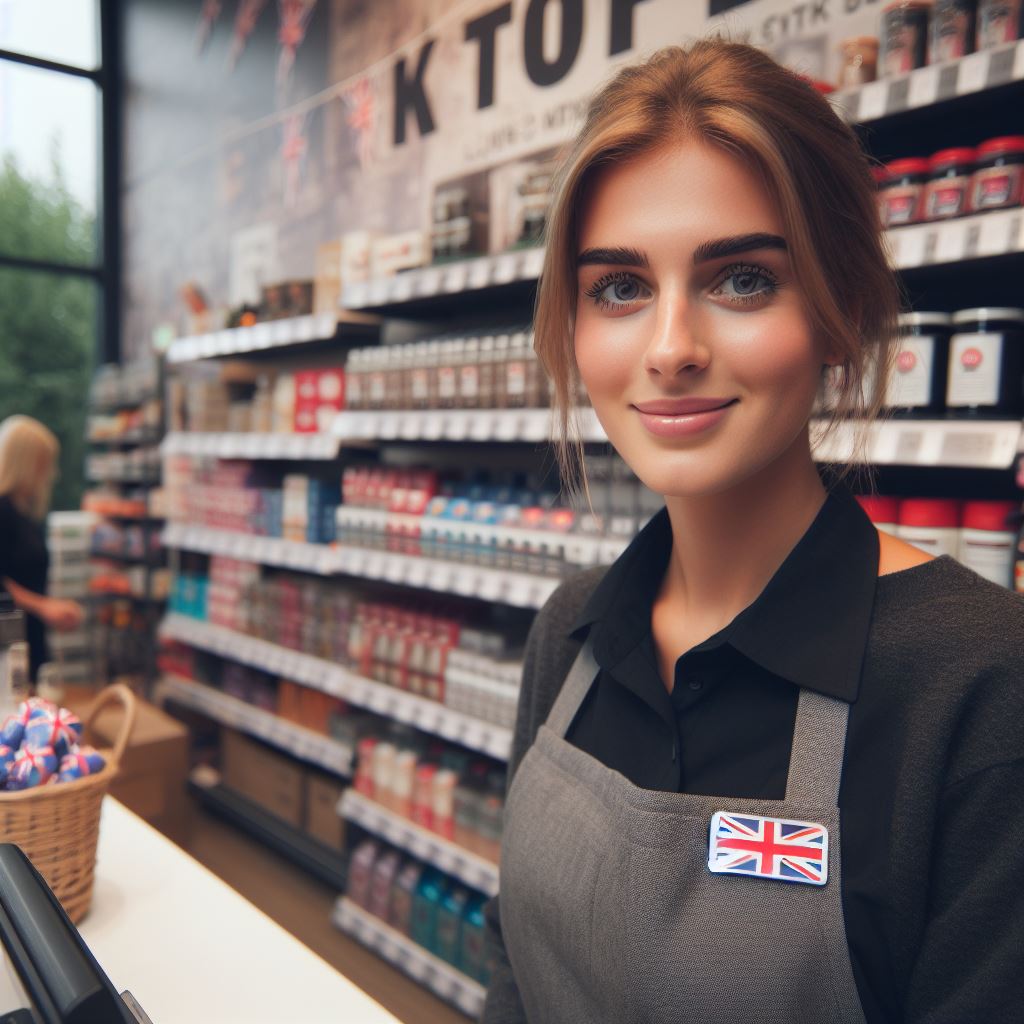Introduction
Merchandising refers to the promotion and sale of products, while cultural impact encompasses the effect of societal values, customs, and beliefs on these activities.
In the UK, cultural influence plays a crucial role in merchandising, shaping consumer preferences and business strategies.
Merchandising involves the process of promoting, advertising, and selling products to consumers in the market.
Cultural impact refers to how societal values, traditions, and beliefs shape consumer behavior, product design, and marketing strategies.
Cultural influence in the UK holds immense importance as it affects consumer preferences, buying patterns, and brand perception in the market.
It influences product design, packaging, messaging, and advertising strategies.
In the UK, cultural factors such as national identity, traditions, and consumer attitudes heavily impact merchandising.
Businesses must understand these nuances to effectively target and engage with their customers.
The UK’s multicultural society demands a sensitive and inclusive approach to merchandising.
Brands that successfully incorporate cultural diversity and inclusivity in their product offerings tend to resonate with a wider audience.
Cultural trends, such as the increasing focus on sustainability and ethical sourcing, also significantly impact merchandising strategies in the UK.
Brands that align with these cultural values gain a competitive edge in the market.
In short, cultural impact plays a vital role in UK merchandising.
Understanding and incorporating cultural factors in product development and marketing is crucial for businesses to succeed in this diverse and dynamic market.
By embracing cultural influence, brands can effectively connect with customers and drive sales.
Personalized UK Career Consulting
Receive tailored career guidance designed just for you. Get actionable steps and expert support to boost your career in 1-3 days. Take control of your career now.
Get StartedHistorical Overview of UK Merchandising
In this section, we will explore the historical development of merchandising in the UK and its cultural impact.
We will examine early forms of merchandising, the introduction of cultural elements, and the evolution of cultural themes in UK merchandise.
Early forms of merchandising in the UK
- The practice of merchandising can be traced back to ancient times when merchants would sell goods at marketplaces.
- In the Middle Ages, merchants began branding their products to differentiate them from competitors.
- The Industrial Revolution in the 18th and 19th centuries brought significant advancements in manufacturing and mass production, leading to the rise of consumer culture.
- With the advent of advertising, companies started using merchandise as a marketing tool to promote their brands and products.
- The popularity of souvenir merchandise also grew during this time, particularly in tourist destinations such as London.
Introduction of cultural elements in merchandising
- In the early 20th century, cultural elements began to be incorporated into UK merchandising to appeal to a wider audience.
- Traditional symbols and icons, such as the British flag and landmarks like Big Ben, were featured on various merchandise.
- Merchandise related to popular British events and celebrations, like the Royal Wedding or the Olympics, became highly sought after.
- The introduction of cultural elements not only enhanced the appeal of merchandise but also created a sense of national pride and identity.
- The influence of British pop culture, including music, films, and television, also began to play a significant role in UK merchandising.
Evolution of cultural themes in UK merchandise
- Cultural themes in UK merchandise have evolved to reflect changing trends and interests.
- Merchandise featuring iconic British musicians, such as The Beatles or Queen, became popular among music fans.
- The rise of British fashion designers and brands led to the inclusion of high-end fashion merchandise showcasing British style and craftsmanship.
- Pop culture phenomena, like Harry Potter, Doctor Who, and James Bond, have generated a wide range of merchandise catering to fans worldwide.
- UK merchandising extends beyond traditional souvenirs, encompassing a diverse range of products that celebrate British culture, heritage, and contemporary trends.
In fact, the historical overview of UK merchandising reveals the gradual integration of cultural elements and their significant impact on the merchandise industry.
From early forms of branding to the incorporation of cultural icons and themes, UK merchandise has evolved to meet changing consumer demands while celebrating British culture.
This fusion of commerce and culture has created a vibrant and diverse market that continues to thrive today.
Read: Merchandising Internships in UK
Popular Cultural Influences on UK Merchandising
Film and television
1. Impact of popular TV shows on merchandise sales
TV shows have a significant influence on merchandise sales in the UK.
The popularity of shows like Game of Thrones and Stranger Things has sparked a high demand for related merchandise.
2. Successful film franchises and merchandise tie-ins
Film franchises like Harry Potter and Marvel have successfully capitalized on merchandising.
Products like action figures, clothing, and collectibles are in high demand among fans.
Music industry
1. Influence of music artists on merchandise trends
Music artists greatly impact merchandise trends in the UK.
Fans often want to show support for their favorite artists through clothing, accessories, and even limited edition items.
2. Concert merchandising and its impact on UK market
Concert merchandising plays a significant role in the UK market.
Exclusive merchandise sold at concerts creates a sense of urgency and excitement, driving sales and fostering fan loyalty.
Your Dream Job Starts with a Perfect CV
Get a tailored CV and cover letter that captures your unique strengths and stands out in your industry. Let us help you make an unforgettable first impression.
Get StartedSports
1. Football and its influence on merchandise sales
Football is a major driver of merchandise sales in the UK.
Fans are passionate about supporting their favorite teams, resulting in high demand for merchandise like jerseys, scarves, and accessories.
2. Major sporting events and their merchandising impact
Major sporting events, such as the Olympics and World Cup, have a massive merchandising impact.
Fans want to commemorate these events by purchasing official merchandise, contributing to a boost in sales.
In essence, various aspects of popular culture have a significant impact on the merchandising industry in the UK.
The influence of TV shows, film franchises, and music artists drives consumer demand for related merchandise.
Sports, particularly football and major sporting events, play a crucial role in driving sales and generating excitement among fans.
Merchandising in the UK thrives on the connection between popular culture and consumer preferences, with fans wanting to express their support and passion through the products they purchase.
Read: Merchandising Tools & Technology
British Brands and Cultural Identity in Merchandising
Use of British cultural symbols and icons in branding
- Many UK brands incorporate cultural symbols like the Union Jack or iconic landmarks in their logo designs.
- This strategy helps to create a sense of national pride and establishes a strong British identity for the brand.
- By using symbols that people can easily recognize and relate to, brands can attract a wider audience.
- Examples include Burberry’s iconic check pattern or Mini’s logo featuring the British flag.
- Such branding not only appeals to UK consumers but also to tourists and international customers.
Emphasizing British heritage and traditions in merchandise
- British brands often highlight their heritage and traditions through their merchandise.
- They incorporate elements such as tartan patterns, traditional craftsmanship, or historical references in their products.
- This emphasis on heritage adds value to the merchandise, making it unique and appealing to consumers.
- For example, brands like Barbour or Hunter create waterproof jackets inspired by British countryside traditions.
- These products showcase a connection to British culture and history, making them desirable to both locals and foreigners.
Reflecting diversity in UK merchandising
- With the UK being a multicultural society, brands have started to reflect this diversity in their merchandise.
- They feature models from different ethnic backgrounds, celebrate diverse traditions, and showcase multicultural collaborations.
- This approach not only promotes inclusivity but also resonates with a wide range of consumers.
- For instance, makeup brands like Fenty Beauty by Rihanna offer a wide range of shades to cater to diverse skin tones.
- By embracing diversity, brands can connect with a more extensive customer base and foster a positive brand image.
Overall, British brands utilize cultural symbols, emphasize heritage, and reflect diversity in their merchandising strategies.
These approaches contribute to the cultural impact on UK merchandising, creating a unique and inclusive experience for consumers.
Read: Visual Merchandising: UK Trends

Globalization and Cultural Diversity in UK Merchandising
Global brands and their adaptation to the UK market
- Global brands have made significant efforts to adapt their products and marketing strategies to the UK market.
- They understand the importance of catering to the cultural preferences and tastes of the UK consumers.
- Some global brands have even modified their packaging, product names, and branding to resonate with the local culture.
- This adaptation allows global brands to establish a strong presence in the UK market and appeal to British consumers.
Incorporation of diverse cultures in UK merchandise
- The UK has a rich cultural heritage and a diverse population, which creates opportunities for incorporating different cultural elements into merchandise.
- Businesses in the UK have embraced cultural diversity and recognized its potential in attracting a wider customer base.
- They have introduced products inspired by various cultures, such as traditional clothing, accessories, and decor.
- By incorporating diverse cultures, UK merchandisers aim to provide a unique and inclusive shopping experience.
Challenges and opportunities of cultural diversity in merchandising
- Cultural diversity in merchandising presents both challenges and opportunities for businesses in the UK.
- A challenge is ensuring an authentic representation of different cultures and avoiding cultural appropriation.
- Merchandisers need to engage in extensive research to understand the cultural significance and context of products they incorporate.
- Despite the challenges, cultural diversity offers opportunities for creating innovative and appealing merchandise.
- By embracing cultural diversity, businesses can tap into niche markets, attract a broader customer base, and foster inclusivity.
- This can also result in economic benefits as customers are more likely to support brands that celebrate diversity.
All in all, the globalization of brands and the incorporation of diverse cultures have had a significant impact on UK merchandising.
Global brands have successfully adapted to the UK market, recognizing the importance of catering to local preferences.
Optimize Your LinkedIn for Success
Boost your LinkedIn profile with a professional bio, keyword-rich headline, and strategic recommendations that attract recruiters. Stand out from the crowd and get noticed.
Optimize NowThe integration of different cultures in merchandise has allowed businesses to provide unique and inclusive options for consumers.
However, challenges such as ensuring authentic representation and avoiding cultural appropriation must be carefully navigated.
Despite these challenges, cultural diversity presents numerous opportunities for businesses to foster inclusivity, attract a wider customer base, and ultimately thrive in the UK market.
Read: Fashion Merchandising in the UK
Future Trends and Predictions for UK Merchandising
Influence of Technological Advancements on Cultural Themes
- Continued advancements in technology will shape and enhance cultural themes in UK merchandising.
- Virtual reality and augmented reality will provide immersive experiences for consumers.
- Artificial intelligence will personalize and tailor merchandising offerings based on individual preferences.
- Online platforms and social media will play a crucial role in promoting cultural themes.
- Interactive displays and smart devices will create a seamless integration between physical and digital experiences.
Sustainability and Ethical Considerations in Merchandising
- Consumers will demand more sustainable and ethically produced merchandise.
- UK merchandisers will focus on eco-friendly packaging and reducing carbon footprint.
- Ethical sourcing and fair trade practices will become the norm in the industry.
- The rise of second-hand and vintage markets will cater to the growing demand for sustainable options.
- Collaborations with environmental organizations will promote awareness and sustainability in merchandising.
Anticipated Shifts in Consumer Preferences and Cultural Influences
- Consumer preferences will lean towards unique and personalized merchandise rather than mass-produced items.
- Local and independent businesses will gain popularity, promoting artisanal and locally made products.
- UK merchandisers will embrace diversity and inclusivity, representing a wide range of cultures and identities.
- The influence of social and environmental activism will drive consumer choices in merchandising.
- Cultural collaborations and cross-pollination of ideas will inspire innovative and diverse merchandise offerings.
In review, the future of UK merchandising will be greatly influenced by technological advancements, sustainability considerations, and shifts in consumer preferences driven by cultural influences.
Technology will enhance cultural themes, while sustainability and ethics will play a crucial role in the industry.
Consumer preferences will shift towards personalized and unique items, supporting local businesses and promoting diversity.
By being aware of these predicted trends, UK merchandisers can stay ahead of the curve and meet the changing demands and expectations of consumers.
You Might Also Like: Retail Tech: Must-Know for UK Managers
Conclusion
The cultural impact on UK merchandising has been significant and has brought about both challenges and opportunities.
It has allowed for the introduction of diverse products that cater to the preferences of different cultural groups.
This cultural impact has influenced the design, marketing, and distribution of merchandise in the UK.
It has led to the incorporation of various cultural elements, aesthetics, and symbols into product designs and branding strategies.
Embracing cultural diversity in the merchandising industry is crucial for success in today’s global market.
It allows businesses to connect with a wider customer base and tap into new markets.
Cultural diversity also promotes inclusivity and fosters a sense of belonging among different communities.
By embracing cultural diversity, businesses can create products that resonate with customers and drive sales.
The future of UK merchandising under cultural influences looks promising.
As the UK continues to be a cultural melting pot, there will be more opportunities to incorporate cultural elements into merchandise and create products that cater to diverse consumer preferences.
the increasing awareness and appreciation for cultural diversity among consumers will lead to a demand for more inclusive and culturally relevant merchandise.
Businesses that recognize this trend and adapt their strategies accordingly will thrive in the market.
The cultural impact on UK merchandising is undeniable.
Embracing cultural diversity is not only important for success in the industry but also contributes to a more inclusive and enriched society.
The future holds immense potential for UK merchandising under cultural influences, and businesses must embrace this opportunity to thrive in the global market.




